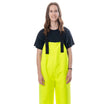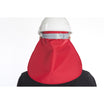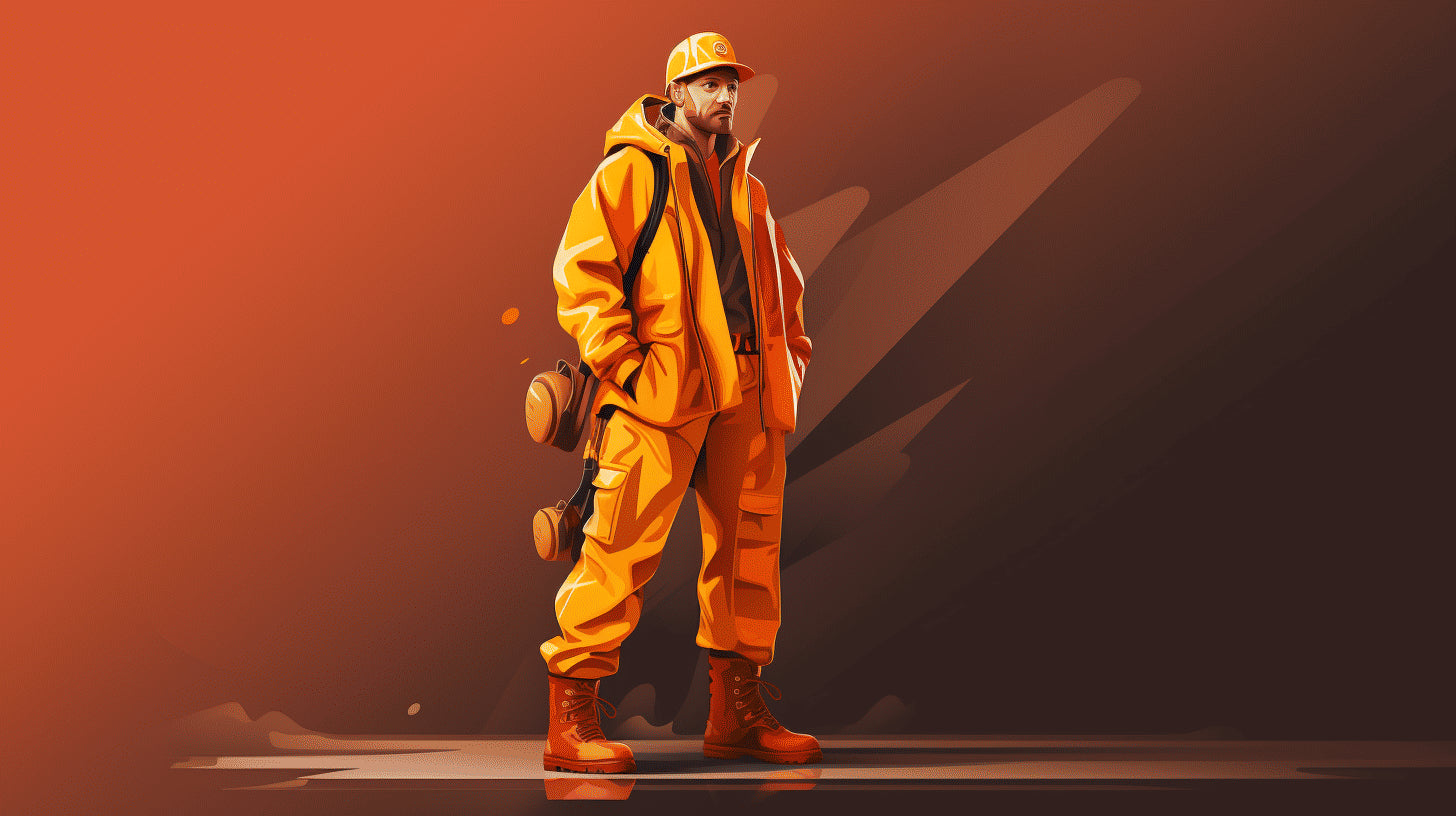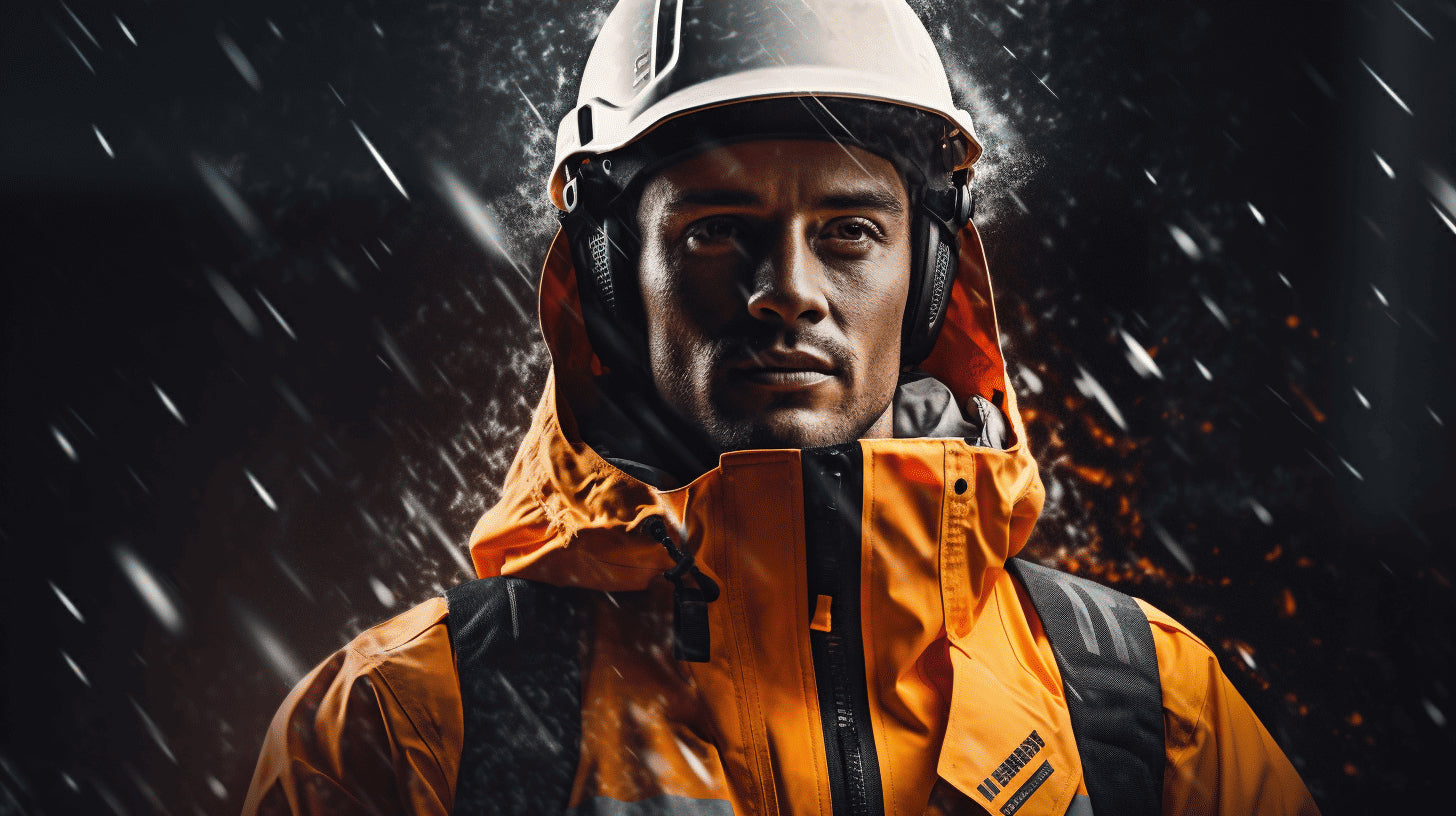The construction industry is a bustling powerhouse of challenges that demand resilience, both in workers and in their gear. Imagine being on a construction site in the middle of a downpour - it isn't exactly pleasant, right? Rain is not an unusual condition for many construction workers globally, and as such, rain gear becomes an indispensable part of their clothing arsenal. But these are not just ordinary raincoats or umbrellas; rather, the rain gear for construction workers needs to be robust, functional, and above all, durable. This article delves into the world of rain gear for construction workers, emphasizing the importance of durability, highlighting the key features of such gear, and discussing the advancements in rain gear technology. We will also touch on relevant safety measures and legislation and offer some insights into career opportunities in construction. So, let's brave the storm - your journey into understanding the ins and outs of durable rain gear in the construction industry begins now.
Importance of Durability in Rain Gear for Construction Workers
When it comes to rain gear for construction workers, durability ranks as the top priority. This is because the gear needs to withstand not only the typical challenges associated with outdoor labor, but also the additional environmental factors that kick in during inclement weather.
Rain gear is designed to protect the wearer from the damp, cold, and sometimes harsh conditions that come with working in the rain. But it isn't just about staying dry - a construction worker's gear needs to be hardy enough to resist tears, punctures, and other forms of damage that could compromise its efficacy. Let's dig a bit deeper into why durability is so crucial in rain gear for workers in the construction sector.
Why Durability Matters
- Longevity: Durable gear lasts longer. This means fewer replacements, less waste, and more savings in the long run.
- Protection: Strong and sturdy rain gear can better resist the wear and tear of a construction site, keeping the worker safe from potential injuries.
- Comfort: Durable rain gear isn't just tough, it's comfortable. It can flex with the worker's movements without tearing, making it much more pleasant to use.
Factors That Contribute to Durability
Material is the biggest contributor to durability. High-quality synthetics, like nylon and polyester, are both tough and water-resistant, being excellent choices for rain gear. Also, construction methods, such as double-stitching and seal-seams, fortify these materials.
Additionally, the inclusion of features like reinforced elbows, knees, or other high-friction areas can provide enhanced durability.
Construction workers often say, "Durability is not an option, but a necessity." This adage rings true when selecting construction gear designed specifically for rain exposure.
So, when shopping for rain gear, it pays to prioritize durability over ephemeral factors like fashion or seasonal trends. Remember, the right gear protects not just your body, but also your productivity and wallet. It's not just about surviving the rain, but thriving in it. Commit to investing in durable rain gear, and you will see the difference not only in your comfort levels, but also in your work performance.
The next time you're tasked with choosing rain gear for construction work, keep durability at the top of your checklist. It's an investment that'll offer returns many times over, proving its worth every time it rains.
Key Features of Durable Rain Gear
When it comes to selecting the best rain gear, durability is a crucial factor to consider. Durable rain gear must effectively protect you from harsh weather while also lasting for a long time. Whether you're going hiking, fishing, or simply rushing to work on a rainy day, durable rain gear can make all the difference. This section will break down the key features you should be looking for in your next purchase.
- Puncture and Tear-Resistance: The most robust rain gear should have a high resistance to punctures and tears. This resistance is often due to the type of fabric used and the quality of construction. You'll need to examine for thick, sturdy materials that won't easily get damaged when in contact with sharp objects or rough surfaces.
- Weight Considerations: Lightweight rain gear can seem like a dream come true, especially for outdoor enthusiasts. However, it's important to remember that durability often comes with a bit of extra weight. So, a balance between lightness and durability should be your aim.
- Ventilation Features: While staying dry in the pouring rain is important, so is comfort and breathability. Thus, look for rain gear with features like air vents or breathable fabric to prevent overheating and perspiration inside the coat.
- Waterproof and Durable Materials: The best materials for durable rain gear are both waterproof and sturdy. Fabrics like nylon and polyester are well-known for these attributes. They resist water penetration and can withstand the wear-and-tear of constant use without breaking down.
- Arc-Rated Gear: This is especially crucial for individuals working in electrically hazardous environments. Arc-rated rain gear provides essential protection against potential arc flash incidents.
- High-Visibility: Look for rain gear with high-visibility features, such as reflective striping. This is often important for safety in low light conditions, especially if you’re hiking or working on a roadside.
- Waterproof Coatings: Many rain gears come with a special waterproof coating on the exterior, such as PVC or Polyurethane. These coatings help enhance the water resistance of the gear, ensuring that you stay dry, even in heavy rain.
- Multilayer Construction: Finally, multilayer construction often means enhanced durability. Each layer serves a purpose - The outer layer for water and wind resistance, the middle layer for insulation, and the inner layer for comfort, all working together to provide the ultimate protection.
Before you purchase your next rain gear, pause and consider these features so you can be confident that your choice will stand up to the elements and last through several seasons.
Advancements in Rain Gear Technology
Gone are the days when a simple umbrella was your best defense against the rain. As humans, we love to push boundaries and constantly innovate, and this is evident in the advancements we've seen in rain gear technology. Just as we've embraced technological advancements in our homes, vehicles, and office spaces, so too have we welcomed major changes in our rainwear.
From jackets to boots, rain gear has transcended the functional and now walks the line of high-tech and high-fashion. It's becoming lighter, more breathable, and, most importantly, waterproof - a triad of features that were once thought impossible to combine. Behind these innovations, dedicated teams are working to ensure that you stay dry, cozy, and stylish during your next downpour.
Over the past few decades, a few standout advancements have paved the way for this new era of stylish, high-performing rain gear:
- Material Technology: The core focus of rain gear advancement is to provide a product that is both water-resistant and breathable. This often centers on the tweaks and innovations done to the materials utilized. From the application of Gore-Tex membranes to the invention of Nano-technology fabrics, the options are limitless.
- Seam Sealing Techniques: Even the best material won't save you from a drenching if the seams of your jacket aren't adequately protected. Companies have developed a diversified mix of techniques to tackle this issue, from fully taped seams to welded ones.
- Design Ingenuity: Aside from materials and construction, design itself has transformed rain gear. Technological advancements have allowed companies to create ergonomic designs which don't just protect, but also enhance the user's comfort and mobility.
At its core, all these advancements serve one purpose: to keep you dry without hindering your movement or comfort. Maintaining breathability while offering waterproof protection—this fascinating balance epitomizes the evolution and future direction of rain gear technology, transforming passive wearers into active users, enjoying and embracing the elements.
This conversation would be incomplete without mentioning the progress made in sustainable methods. Increasingly, companies are consciously reducing their environmental impact by integrating recycled materials as well as offering repair and recycling programs for their products.
"Rain, rain, go away" is a phrase of the past. With these advancements in rain gear technology, there's no such thing as bad weather, only unsuitable clothing. So the next time it pours, go ahead and embrace it—it's an opportunity to showcase some incredible fashion tech. After all, even rainy days can have their silver linings.
Safety Importance of Comfortable and Durable Rain Gear
Construction workers know that their job can be demanding and hazardous, especially when weather conditions take a turn for the worse. When a drizzle turns into a downpour, a project can't simply stop; thus, having comfortable and durable rain gear becomes essential for every worker on the ground. Not only does rain gear safeguard employees from the discomfort of getting soaked, but it also plays a crucial role in preventing falls and other injuries.
A good set of rain gear provides the following advantages:
- Protection from harsh weather: It shields workers from rain, cold wind, and even the occasional hail. An overheated or shivering worker is a distracted one, and distraction can lead to accidents.
- Visibility: Most rain gear is brightly colored or has reflective stripes to make the wearer significantly noticeable against a gloomy rain-soaked backdrop.
- Mobility: Quality rain gear is designed to allow full range of motion, ensuring workers can move freely and perform their tasks without hindrance.
- Durability: High-quality rain gear is crafted to withstand the rigors of a construction site and the elements, lasting longer and providing consistent protection.
Comfortable and lasting rain gear is a must and can influence the risk of falls and injuries significantly on a construction site. As correctly stated by safety experts, proper safety equipment, including rain gear, reduces the risk of falls and injuries for construction workers.
Therefore, construction companies must never downplay the importance of investing in top-notch rain gear. These essential pieces of safety equipment are crucial for employee well-being, productivity, and overall job site safety. Let's ensure the workers have what they need to remain safe and effective in even the most torrential conditions. By doing so, we'll continue to reduce the risk and incidence of workplace accidents, safeguarding our most precious resource: our workers.
Invest in safety, save in productivity.
Training and Apprenticeship Programs
Pathways to Expertise
Stepping forward into the world of work might often seem like a leap into the unknown. However, with the appropriate guidance and practical experience, the transition can be both exciting and rewarding. This is precisely the aim of Training and Apprenticeship programs. They bridge the gap between theoretical knowledge and real-life application, providing a hands-on approach towards acquiring technical skills and expertise.
Training and apprenticeship programs are available across a wide variety of industries. One such example is the construction industry. From the intricate art of bricklaying to the precise science of rain gear installation, each area of this expansive field offers unique learning opportunities.
Let's dig a little deeper into why these training and apprenticeship programs are an excellent option for eager learners looking to mark their niche in the booming construction world.
Learn While You Earn
Nobody likes the idea of unpaid internships. Unlike such arrangements, apprenticeships are 'earn while you learn' programs. As an apprentice, you're an employee. You are paid a wage for the work you do while at the same time learning the ins and outs of the industry.
Get Hands-on Experience
Watching tutorials online or reading about a technical skill is one thing. Actually applying that skill in a practical setting adds a whole new layer to the learning process. As an apprentice, you get the opportunity to apply the skills you learn - right there, on the job!
Learn from Industry Experts
Who better than seasoned professionals to guide you through the maze of the industry? These mentors can provide you with invaluable industry insights, advice, and support throughout your journey.
Craft a Solid Foundation
An apprenticeship program equips you with the skills and knowledge you need to start your career in a particular industry. It's your first step towards mastery. After your apprenticeship, you can explore opportunities for further training or education – or, if you prefer, delve right into the working world.
Take, for instance, the field of rain gear installation in the construction world. Apprenticeship programs will prepare you for the specific needs and demands of this niche area. Handling multiple projects, sourcing the best materials, strategic planning, and efficient execution all fall under your learning purview. It's a comprehensive course to equip you for a successful career ahead.
Regardless of your chosen field, training, and apprenticeship programs mark a crucial milestone on your path to expertise. They showcase the perfect blend of theoretical knowledge and practical application, ensuring both professional growth and skill refinement. So, rise and shine, budding professionals! The world is waiting for your expertise.
Hot Weather Adaption Measures
As the sun blazes hotter, construction workers bear the brunt of the scorching heat. The need for effective hot weather adaptation measures on construction sites cannot be emphasized enough. It's not just about comfort; it's more about health, safety, and overall productivity.
Construction work, as demanding as it is, coupled with extreme heat, can lead to serious health risks like heat stroke, heat exhaustion, and dehydration, among others. Therefore, employers and employees need to unite in taking active steps to ensure that measures are appropriately in place to manage heat in the workplace, not only for the workers' safety but also for the successful completion of their projects.
There are quite nuanced, yet significant steps to achieve this. Here are some strategies to adapt to hot weather on construction sites:
- Stay Hydrated: Being the most immediate and impactful measure, workers should always have access to clean and cold water at intervals throughout the day. Hydration helps regulate body temperature and replenishes lost fluids through sweat.
- Regular Breaks: During extreme heat, it's advisable to take more frequent breaks in a cool, shaded area. It gives the body an opportunity to recover and reduces the chance of heat-related illnesses.
- Heat-Resilient Clothing: Lightweight, light-colored, and loose-fitting clothes with breathable fabric are recommended. Some manufacturers even offer heat-resistant and moisture-wicking clothing, which can significantly beat the heat.
- Training: It's imperative for both supervisors and workers to be knowledgeable about heat-related illnesses, their symptoms, and first-aid measures. This information could potentially save lives and should be a part of workers' ongoing training.
- Starting Early: If possible, scheduling work during the cooler parts of the day like early morning and late evenings can be a sensible approach to avoid the peak temperatures of midday.
- Sun Protection: Using sunscreen, wearing wide-brimmed hats, and setting up temporary shade structures can protect workers from direct sunlight.
Mixed feelings could arise regarding the implementation of these measures; however, they're non-negotiable during the summer season, which is particularly marked by high temperatures. The key is in the details when it comes to executing a proper hot weather adaptation plan, but its benefits for workers' well-being and project success are extensive.
Remember, hot weather doesn't have to be a hindrance. With the right adaptation measures, construction workers can maintain their productivity levels and health, despite the rising mercury. Implementation of such measures will go a long way in ensuring safe construction sites and happier, healthier workers. Moreover, a well-planned strategy can seamlessly integrate these measures into construction routines, turning the summer sun from foe to friend. So, let's build not just structures but also a conducive environment for our workers.
Relevant Legislation for Safety and Training
Whether you're a seasoned construction professional or a rookie just getting started, safety and proper training are aspects of the job you simply can't overlook. While many organizations voluntarily implement safety measures and offer comprehensive training programs, there are laws in place that demand adherence to certain standards.
Specific legislation acts as the backbone of safety regulations and training protocols in the construction industry. Often these laws are necessitated by the inherently hazardous nature of construction work, aiming to reduce worksite injuries and ensuring all workers are equipped with the necessary skills and knowledge.
These regulations govern various areas related to construction safety, including but not limited to:
- Worker Health and Safety: This concerns the provision of appropriate safety gear, maintaining healthy work environments, and fostering a culture of safety. Employers are often required by law to provide the necessary equipment that protects workers from potential harm.
- Training and Skill Development: Here the focus is on ensuring all workers are adequately trained for their assigned tasks. Legislation makes it mandatory for construction companies to offer comprehensive and regular training programs.
- Hazard Identification and Control: Construction work frequently involves potential hazards. As such, laws exist that require hazards to be accurately identified and controlled.
Now you may wonder, "what's the relevance of such legislation to me?" And, indeed, it's a valid question. If you're a construction worker, the legislation directly affects your safety and ongoing professional development. Whether you're operating heavy machinery or installing insulation, these laws assure you're protected and adequately skilled for the job.
For construction business owners and managers, adhering to such legislation is not just a matter of legal compliance; it's a matter of maintaining a reputation for safety and quality. If a company is found to be non-compliant, they could face hefty fines or, worse, forced closures.
Relevant legislation for safety and training in the workforce shouldn't be perceived as a burden. Instead, it's a framework that allows everyone involved in construction work to tackle their tasks confidently and safely. Such laws reflect the importance of each worker's life and health and emphasize the significance of persistent learning and development in a dynamic industry like construction.
Precautionary Measures: Asbestos Removal
Asbestos, a naturally-occurring mineral with unique heat resistance properties, was once widely used in the construction industry. However, recent discoveries have evidenced that it might pose serious health risks. Luckily, specially trained professionals have been developed techniques for the safe asbestos removal and disposal. But precautions must be taken before these experts can get to work on your major installation projects.
When it comes to asbestos disposal, the priority should always been safety. The first step in this process is determining if you do indeed have asbestos. This isn't something the average person can do with the naked eye, which is why it's recommended to hire certified asbestos inspectors.
After identifying asbestos, specially trained workers are brought in. Donning protective gear, they seal off the contaminated area to prevent any material from escaping. Employing specialized tools and techniques, they then remove the asbestos, ensuring not to disturb or break it too much, as this can release harmful fibers into the air.
Importantly, once removed, asbestos must be disposed of correctly. It cannot simply be dumped with regular construction waste. Rather, it needs to be sealed in thick plastic bags, tagged, and transported to a facility equipped to handle such waste.
So, before you embark on your next construction project that involves installing new insulation, bear in mind the following steps:
- Confirm the presence of asbestos. You'll need professional, certified inspectors to do this.
- Involve specially trained asbestos workers for removal.
- Make sure the workers wear protective gear, seal off the contaminated areas and use the correct removal techniques.
- Dispose of the removed asbestos properly. It must be sealed, tagged, and taken to an approved disposal facility.
"Asbestos removal should be conducted by specially trained workers before installing new insulation in construction projects."
In other words, don't take the job lightly. Make the necessary precautions and trust the experts when it comes to dealing with this potentially hazardous material. Ignorance is not an excuse when it comes to the safety of all involved in the project. With proper management, asbestos removal can be handled professionally and safely, paving the way for your new insulation installation.
Use of PVC Tarpaulins in Construction
Picture this: A rain-soaked construction site with wet building materials, glistening equipment, and desolate workers huddling for shelter. A disheartening visual, isn't it? Every construction professional dreads the sight of precious time and materials being wasted due to unpredictable weather. But, what if we told you there's a way to avert such scenarios? Yes, it's possible thanks to PVC tarpaulins!
PVC (Polyvinyl Chloride) tarpaulins are a construction site's first line of defense against harsh weather conditions. Whether it's blazing sun, driving rain, or freezing snow, these formidable coverings protect both workers and their tools from the elements. Additionally, they also serve as temporary building enclosures during periods of construction.
Here's why PVC tarpaulins are considered indispensable in the field of construction:
- Weather Resistance: Their resilience to varied weather conditions makes them a must-have. PVC tarpaulins can withstand extreme temperatures, being both frost and heat proof. Regardless of the climate, this material remains a steadfast shield.
- Durability: PVC tarpaulins are robust and long-lasting. They resist tears and punctures, able to handle the rigorous demands of a construction site. Their longevity means they offer exceptional value for money.
- Versatility: There's an impressive range of sizes and colors. Whether it's a small building project or a towering skyscraper in the making, PVC tarpaulins cater to all construction needs.
- Ease of Use: These tarpaulins come equipped with rust-free eyelets at regular intervals, ensuring convenient fixing and removal. They're light enough for easy handling while remaining solid enough to stay put.
"Thanks to PVC tarpaulins, it's no longer 'rain, rain, go away', but rather 'rain, rain, that's okay."
When you are at the crossroads of choosing the right protective gear for your construction site, remember that it's not about surviving the storm, but learning to dance in the rain. With PVC tarpaulins, construction can continue unabated even in the most challenging weather conditions. It's time to bid farewell to construction delays caused by Mother Nature: let's weatherproof our worksites with PVC tarpaulins.
Guides and Standards for New Buildings
Embracing the art of architecture is no less significant than conducting a symphony. Both demand knowing how to harmonize an assortment of elements into a finely tuned end product. However, in the realm of constructing new buildings, having crystal-clear guidance and up-to-standard regulations is crucial, and it's the bread and butter of what BC Housing Design and Construction provides.
Primarily focusing on the design and construction of new buildings, BC Housing Design and Construction Standards serve as a compass for professionals in the field. These guidelines create a perfect blend of function, safety, aesthetic, and environmental considerations.
While these standards cover a wide variety of elements, it's worth highlighting some key aspects:
- A strong emphasis on sustainable design principles. BC Housing is committed to designing buildings that are environmentally friendly, energy-efficient, and contribute to a healthier lifestyle for its residents.
- With stringent criteria for materials, the requirement for quality and durability is heavily emphasised to guarantee longevity and a reduced need for maintenance.
- An interesting feature is the focus on preparing buildings for the rainy season. BC Housing Standards stipulate specific rain gear requirements, ensuring that the exterior of the buildings can withstand harsh weather conditions.
These guidelines are set as a lifeline for design and construction professionals, and adherence to them will surely yield a successful project. Further, by abiding by the standards set forth by BC Housing, every new building made stands as a beacon of sustainability, quality, and all-weather resilience.
In an era where environmental responsibility is a pressing concern, following tried-and-trusted standards is just one way we can contribute to a more sustainable future – and BC Housing Design and Construction Standards are leading the charge for new buildings. The more we can adhere to these standards, the brighter our architectural landscape will be. And, just maybe, the better our world will be for it.
"Architecture is the learned game, correct and magnificent, of forms assembled in the light" - Le Corbusier. And today, the charm of architecture has tangoed with the urgency of sustainability to present a timeless dance. The dance is an elegant blend of innovation, design, durability, and a strong stance against climate change, just as depicted in every new building birthed with the BC Housing Design and Construction Standards.
Career Opportunities in Construction and Related Sectors
Are you looking to forge a dynamic and exciting career path that requires skill, creativity, and grit? The world of construction and related sectors just might be the perfect fit for you. Not only does this industry offer a vast array of job roles, but it also holds promising growth potential. But don't merely take our word for it; we'll take you on a detailed exploration, touching upon the numerous opportunities present in not just construction, but also other related spheres such as energy, mining, and environmental. Let's dig deeper!
The Alluring World of Construction
The construction sector is a cornerstone of the economical infrastructure, offering an array of exciting careers built upon skill and creativity. From Collaborative Architects and Civil Engineers making blueprints a reality to Foremen leading the charge on the ground. There's something for every skillset. Potential job roles include:
- Civil Engineers
- Architects
- Quantity Surveyors
- Construction Managers
- Electrical Engineers
- Structural Engineers
- Project Managers
All of these professions stand distinct, making a significant contribution to the industry's overall success.
Powering Up With Energy Sector
The energy sector, vast and varied, has continually proven to be a lucrative field, teeming with numerous career avenues. From researching renewable sources such as solar and wind power to conserving the existing resources, the energy sector is dedicated to meeting the world's ever-growing power needs. These are among the roles that can be pursued:
- Energy Engineers
- Nuclear Engineers
- Petroleum Engineers
- Sustainability Consultants
- Solar Photovoltaic Installers
- Wind Turbine Technicians
Unearthing Possibilities: Mining Sector
Mining serves as the foundation of our modern civilization, driving economies and providing the materials necessary for almost every industry. It offers opportunities for individuals interested in Geology, Engineering, Metallurgy, and Environmental Science. Here are some potential roles:
- Mining Engineer
- Geologist
- Metallurgist
- Mine Surveyor
- Drill and Blast Engineers
- Environmental Consultant
Environment Sector: Jobs for the Planet
In our era of societal awakening towards environmental concerns, opportunities within this sector are expanding rapidly. These roles provide critical solutions to environmental problems, working towards a sustainable future. Some exciting roles are:
- Environmental Scientists
- Conservation Scientists
- Hydrologists
- Environmental Engineers
- Waste Management Officers
- Renewable Energy Managers
It's refreshing to know companies like Morgan are leading the way in providing these exciting career opportunities not just in construction, but also across energy, mining, and environmental sectors. So, are you ready to build a robust future? Be it laying the groundwork as a civil engineer or brainstorming renewable solutions as an energy specialist, the opportunities are as diverse as they are rewarding. It's clear to see, there's an abundant future in these fields, ready for the taking!
Conclusion
In the demanding field of construction, wearing the right gear is paramount. As we've explored, the importance of durability in rain gear cannot be understated. From puncture and tear resistance to high visibility, it's evident that not all rain gear is created equal. In this rapidly advancing world, we're witnessing a continuous evolution within rain gear technology, with a firm focus on safety and comfort. At the end of the day, a comfortable worker is a safe and productive worker!
As industries shift and grow, so do opportunities within construction and related sectors. Indeed, ongoing advancements and regulations underpin this progression. And let us not forget, training is just as crucial - it helps ensure we're not just fully equipped with the best gear but armed with vital knowledge too.
Remember, when bracing against the elements, there's no room for compromise. Protecting yourself from harsh weather conditions is vital, so invest in top-quality gear, like Hurricane Raingear. Handcrafted in the Pacific North West, these products are known for their superior durability and comfort, making them trusted by thousands of satisfied customers.
At the heart of it all, prioritizing safety, comfort, and quality of rain gear can significantly enhance a construction worker's experience, performance, and well-being. Here's to building healthier, safer, and more resilient work environments, come rain or shine!
Frequently Asked Questions
-
What is the most durable material for rain gear for construction workers?
The most durable material for rain gear for construction workers is typically PVC (polyvinyl chloride) or PU (polyurethane) coated fabrics. These materials are waterproof, abrasion-resistant, and provide excellent durability in harsh conditions.
-
Are there specific features to look for in rain gear for construction workers to ensure durability?
Yes, when selecting rain gear for construction workers, features to consider for durability include reinforced seams, heavy-duty zippers, adjustable cuffs and hems, and double-layered material in high-wear areas.
-
How long can a durable rain gear for construction workers typically last?
The lifespan of rain gear for construction workers can vary depending on the quality of materials and usage. However, with proper care and maintenance, a durable rain gear can last anywhere from 1 to 5 years.
-
What should I do to maintain the durability of rain gear for construction workers?
To maintain the durability of rain gear, it is recommended to follow the manufacturer's care instructions, avoid using harsh chemicals or abrasive materials during cleaning, and store the gear properly in a dry and ventilated area.
-
Can I use rain gear for construction workers in other outdoor activities?
Yes, rain gear designed for construction workers can generally be used for other outdoor activities such as hiking, camping, and fishing. However, consider the specific features and requirements of the activity to ensure the gear meets your needs.





















Leave a comment
This site is protected by hCaptcha and the hCaptcha Privacy Policy and Terms of Service apply.